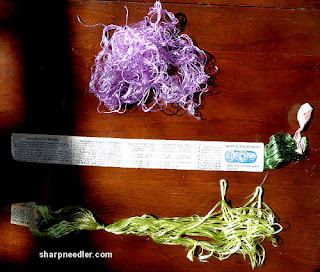OK, perhaps more than a little bit crazy, but it sure has been fun!
Before I could start stitching on the Society Silk violet centrepiece, I had to rummage through my cache of antique threads to find appropriate colours. I have threads in all sorts of varying levels of usability as you can see in the photo below.
These are pretty much the standard conditions that I encounter with antique threads. The top thread is a tangled mess and is the least desirable. The middle thread is in its original wrapper and this particular one is in pristine condition. Often, threads in these wrappers are worn on one end resulting in very short lengths with which to stitch. I generally avoid threads in the old paper wrappers.
The bottom thread is in the best condition when it comes to stitchability. When the silks come as a skein with a knot in the middle, they are generally in a good usable state.
The threads might look a mess, but they are mostly fine. There are a couple of skeins that are problematic; they have unbreakable knots so I'll have to cut lengths of thread from around the knots. However, they need to be used up so that's fine. The stitched elements on the doily are so small that small lengths of thread are not a problem.
You can also run into issues like worn areas in the middle of threads. You just have to work around them. I'd say flexibility is key to working with antique supplies!
To Shade or Not to Shade
I've decided not to stitch the violets in true Society Silk style.
In general, there's not a lot of shaded definition in the embroidery on Society Silk pieces. The elements are rather flat, colourwise. There are exceptions, but my observation is that most elements are either stitched in a single colour or have minimal shading.
In this example with violets, there's a bit of shading, but not much.
I'm going to add more shading to my violets because, well, I like shading. Big surprise, right?
Even so, shading on my tiny little flowers will be challenging. Most petals will have three or four shades. Also, since I don't want to waste thread I'm not putting in a split stitched edge before filling the petals. This means I have to pay really close attention to my edge stitching, and I'm sure there will be places where the edges are not as smooth as I'd like.
The other thing I'm doing to save thread is to use split stitch for the stems rather than stem stitch.
Stitching with Antique Silk
The silk is about the same width as one strand of DMC cotton floss (DMC is the gold thread in the photo below). The silk might be a bit finer once under tension.
I haven't stitched with nearly flat filament silk for quite a while. The skeins catch on my fingers as I would expect, but I am having no problems with the individual strands catching on my fingers when I'm stitching. In fact, the thread is wonderful to stitch with. It feels really nice.
One Motif Done
I have completed one motif except for the gold centres, which I'll do all at once at the end of the project.
I wasn't overly happy with the motif after I initially completed it, but I looked at it the next morning and liked it better, especially when I saw it in the context of the whole piece. It looks like Society Silk. I have a real sense of having stepped into the past (and I didn't even need a TARDIS).







Wow, this looks really nice! It will be interesting to see you progress on this piece.
ReplyDeleteThanks, Jessica. I feel incredibly privileged to be stitching this project.
Deleteas a novice stitcher I am finding this fascinating. Thank you for sharing this project with us.
ReplyDeleteI'm so happy that I am able to share and I must say that the pleasure is definitely mine! :-)
DeleteVery lovely, I do love violets and will be anxious to see the finished project.
ReplyDeleteThank you, Judy. I, too, love violets and can't wait to see what this looks like when it's finished! :-)
DeleteYour sample motif is beautiful - your shading choices are lovely - and this is a really neat project! The idea of stitching an antique kit with period threads is incredibly intriguing; no doubt it will be challenging, but the process will be so interesting to see! Such a wonderful tribute to the talented needlewomen of the past :)
ReplyDeleteThank you, Aurelia, and definitely a tip of the hat to the needlewomen of the past!
DeleteDear Margaret,
ReplyDeleteYour shading is always so incredibly beautiful, inspiring.
Anna-Maria, thank you for your very kinds words.
DeleteI like it so far!
ReplyDeletebeautiful shading. I haven't really learned how to do that. This may inspire me
ReplyDelete